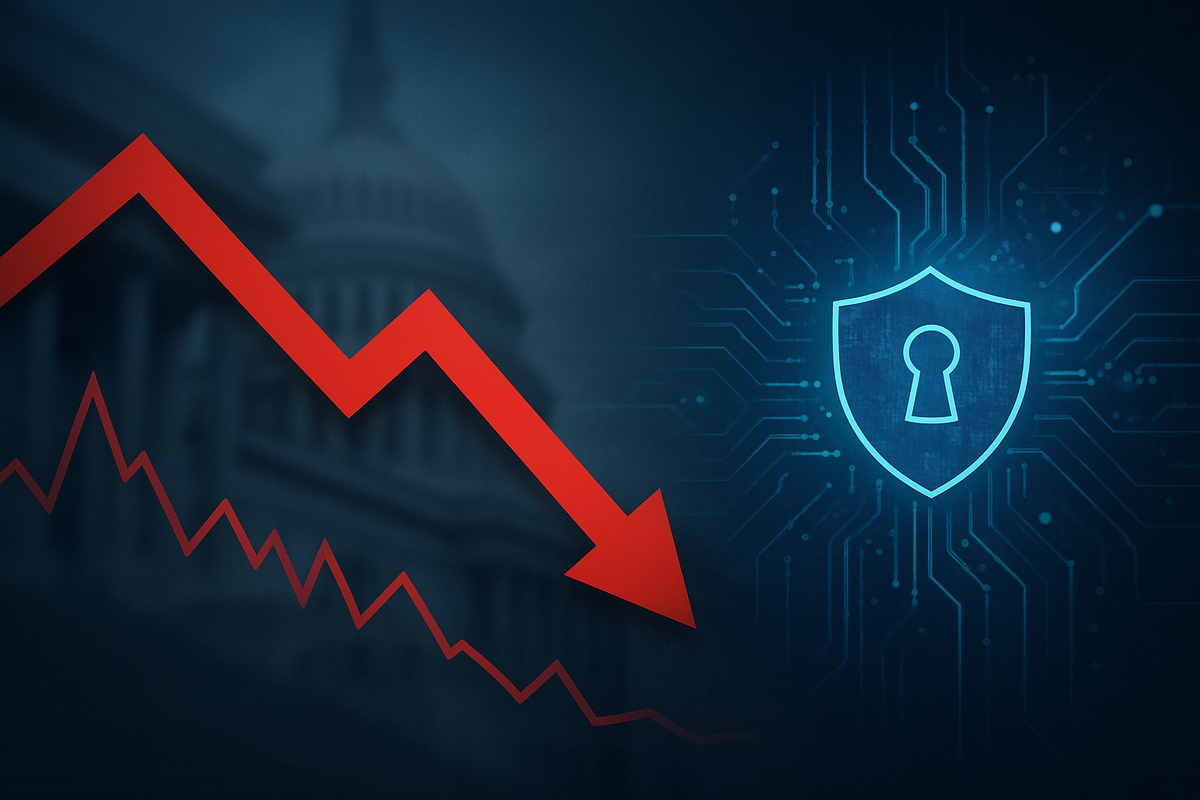
Booz Allen Hamilton (NYSE: BAH) experienced a significant downturn on October 24, 2025, as its stock plummeted to a new 52-week low following the release of its fiscal second-quarter 2026 earnings report. The consulting giant's shares fell sharply after it not only missed analyst expectations for both revenue and adjusted earnings per share but also significantly slashed its full-year guidance, sending ripples of concern through the market. This immediate negative reaction underscores investor apprehension regarding the company's future performance, particularly in its beleaguered civil sector.
The sharp decline to a two-year low of $88.11 highlights a challenging period for the government contractor. The revised outlook points to a more protracted struggle than previously anticipated, raising questions about Booz Allen Hamilton's ability to navigate a difficult federal contracting landscape and adapt its strategy to prevailing market conditions.
Disappointing Q2 Results and a Grim Outlook
The core of Booz Allen Hamilton's recent market woes stems directly from its fiscal second-quarter 2026 results, which painted a grim picture. The company reported adjusted EPS of $1.49, falling short of analyst estimates ranging from $1.51 to $1.53. Revenue also disappointed, coming in at $2.9 billion against expectations of $2.97 billion to $3 billion, marking an an 8.1% year-over-year decline. However, the most alarming aspect for investors was the drastic revision of its full-year fiscal 2026 guidance. Adjusted EPS was lowered to $5.45-$5.65 from a previous $6.20-$6.55, while revenue guidance was cut to $11.3 billion-$11.5 billion from $12 billion-$12.5 billion. This substantial reduction signaled a deeper and more prolonged challenge than the market had priced in.
The immediate aftermath saw Booz Allen Hamilton's stock tumble between 8.6% and 10%, hitting a low of $88.11 and settling around $90.09. This sharp sell-off was a direct response to the disappointing figures and the bleak forward-looking statements from management. The timeline leading up to this moment has been characterized by increasing skepticism surrounding government spending, particularly in the civil sector, a trend that Booz Allen Hamilton had previously acknowledged but perhaps underestimated in its impact.
Management attributed the significant miss and guidance cut primarily to a "prolonged reacceleration" in its civil sector business, describing it as "the most challenging market in a generation." This segment faced a substantial expected decline, with forecasts suggesting a low 20% range decrease or an additional 30% decline for the second half of fiscal year 2026. Factors cited included a continued funding slowdown, persistent procurement friction, a lack of major government contract "plus-ups," and ongoing uncertainty regarding government budgets, exacerbated by risks of potential government shutdowns. Challenges tied to the presidential transition were also noted as impacting the civil side more significantly.
While Booz Allen Hamilton's national security portfolio continued to demonstrate robust performance and secure significant contract wins, these successes were insufficient to counteract the severe headwinds faced by the civil segment. The disproportionate impact on the civil side, compared to other contractors, raised specific concerns. Following the earnings call, Bank of America consequently downgraded Booz Allen's stock, directly referencing the magnitude of the civil segment's decline as a key concern, further solidifying the negative market reaction.
Shifting Sands: Winners and Losers in the Government Contracting Arena
Booz Allen Hamilton's (NYSE: BAH) recent struggles in its civil sector highlight a significant recalibration within the broader government contracting industry, creating a landscape of potential winners and losers. The pronounced slowdown in civilian agency spending, coupled with budget uncertainties and the "prolonged reacceleration" described by Booz Allen's CEO, suggests that contractors with heavy exposure to this segment are likely to face similar headwinds, while those with a stronger defense and national security focus may prove more resilient.
Companies with substantial civil sector exposure, such as Leidos (NYSE: LDOS), Science Applications International Corp (NYSE: SAIC), and CACI International (NYSE: CACI), could find themselves navigating similar turbulent waters. Leidos, with its significant contracts across various civil agencies like the Federal Aviation Administration (FAA), Department of Veterans Affairs (VA), and National Institutes of Health (NIH), may experience pressures on its contract pipeline and revenue growth if federal civilian spending remains constrained. Similarly, SAIC, which supports agencies like Customs and Border Protection, the State Department (Vanguard program), and the Treasury Department (T-Cloud), despite its CEO's confidence, could face challenges as the broader trend of federal cost-cutting takes hold. While CACI International (NYSE: CACI) is more heavily defense-oriented, its involvement with homeland security, intelligence, and healthcare agencies means that a widespread contraction in civilian IT or support services could still affect its adjacent civil-related contracts. The restructuring and layoffs announced by Booz Allen Hamilton in its civil division underscore the severity of the market conditions in this segment, signaling a potentially tougher operating environment for all players.
Conversely, companies predominantly focused on defense and national security are likely to be more insulated and could even emerge as relative winners. General Dynamics (NYSE: GD), an industry giant with an overwhelming focus on aerospace and defense systems, is well-positioned to weather the civil sector downturn. Its core business in weapons systems, advanced technology, and military hardware provides a stable foundation, and investors may increasingly view it as a safer haven. Even within companies like Leidos (NYSE: LDOS), SAIC (NYSE: SAIC), and CACI International (NYSE: CACI), their robust defense and intelligence portfolios, particularly in high-growth areas like cybersecurity and AI for national security, are expected to continue performing strongly, potentially offsetting some of the civil segment weaknesses. The competitive landscape will likely see intensified bidding for scarcer civil contracts, potentially squeezing margins, while a strategic shift towards mission-critical defense and intelligence technologies becomes even more paramount for sustained growth.
Wider Significance: A Bellwether for Federal Contracting Shifts
Booz Allen Hamilton's (NYSE: BAH) civil sector woes are more than just an isolated corporate setback; they serve as a significant bellwether for broader, potentially enduring shifts within the federal contracting landscape. The stark divergence between the robust performance of its national security portfolio and the "challenging market" in its civil business underscores a growing bifurcation in government spending priorities, with defense and intelligence remaining strong while civilian agencies face increasing fiscal pressure.
This trend fits into a larger narrative where national security, driven by geopolitical tensions and rapid technological advancements in areas like AI and cybersecurity, continues to command significant federal investment. Booz Allen's success in securing $7.2 billion in gross bookings, with approximately 90% in national security, exemplifies this resilience. Conversely, the civil sector is grappling with procurement delays, slower funding increments, and heightened pricing pressures. This environment creates ripple effects across the industry, intensifying competition for scarcer civil contracts and potentially squeezing margins for all players. Smaller and mid-sized contractors heavily reliant on federal civilian agencies are particularly vulnerable, facing reduced opportunities and potential cash flow disruptions if they cannot adapt or diversify.
Regulatory and policy implications further complicate this picture. Ongoing government budget debates and the perennial risk of shutdowns inject considerable uncertainty, potentially halting new awards, suspending performance, and delaying invoice processing. More significantly, the landscape is being shaped by the prospect of a presidential transition and initiatives like the proposed Department of Government Efficiency (DOGE). Should DOGE be implemented, its focus on streamlining operations and reducing wasteful spending could lead to more stringent contractor evaluations, increased pressure for cost reductions, and potentially a reevaluation of larger contracts. While this might open doors for innovative, cost-saving solutions and perhaps small businesses, it could also result in fewer contracts overall or significant modifications, creating an environment of payment delays and exhaustive contract reviews.
Historically, the industry has faced similar periods of federal spending contraction, most notably during the 2013 sequestration. That event led to across-the-board budget cuts, reductions in new contracts, increased competition, and a shift towards firm-fixed-price contracts. The lessons from sequestration — the need for contingency planning, agility, and a focus on high-priority, mission-critical areas — are highly relevant today. Booz Allen's current challenges in the civil sector, therefore, reflect not just company-specific issues but a broader, evolving federal market where strategic adaptation, cost efficiency, and a keen understanding of shifting government priorities are paramount for survival and growth.
What Comes Next: Navigating a Bifurcated Future
The path forward for Booz Allen Hamilton (NYSE: BAH) and the broader government contracting industry is defined by a strategic pivot and a navigation of a "bifurcated environment" where national security remains robust, but the civil sector faces prolonged headwinds. In the short term, Booz Allen's immediate focus will be on managing the fallout from its civil business struggles and implementing its announced restructuring.
The company's plan to lay off approximately 7% of its workforce, predominantly in the civil segment, signals a decisive effort to align costs with anticipated reduced demand. This "resetting and restructuring" aims to stem the civil sector's expected "low double-digit" revenue decline for fiscal year 2026, with some analysts bracing for an even steeper 30% decrease in civil revenue in the latter half of FY2026 and early FY2027. This includes the conclusion of major programs like a significant Veterans Affairs Department contract, which previously accounted for a substantial portion of BAH's revenue. To counter this, Booz Allen is aggressively doubling down on its national security portfolio, which constitutes 64% of its 2025 revenue and continues to exhibit strong growth. This strategic shift involves significant investments in Artificial Intelligence (AI), cybersecurity, and warfighting technologies, areas where federal spending remains a high priority.
Looking long-term, Booz Allen's success hinges on its ability to effectively execute this strategic pivot towards high-growth, high-margin areas. The company's position as the largest AI provider to the federal government, with its AI segment growing over 30% in fiscal 2025, positions it for significant future opportunities as AI adoption becomes widespread across federal agencies, including for cybersecurity and procurement. Its leadership in cybersecurity, evidenced by its "Thunder Dome" product, also aligns perfectly with escalating federal demand for robust cyber defenses. Furthermore, investments in warfighting technologies and a substantial venture capital fund targeting emerging technologies underscore a proactive approach to future innovation. However, significant challenges remain, including the risk of sustained civil sector weakness, intense competition from tech giants like Palantir and Microsoft in critical tech domains, and ongoing government budget uncertainty.
Potential scenarios for Booz Allen Hamilton's stock and market position are varied. A bullish scenario sees the company successfully navigating the civil downturn, rapidly scaling its defense, AI, cyber, and warfighting segments, leading to renewed growth and a rebound in stock value, potentially reaching analyst price targets well above current levels. Conversely, a bearish outcome could involve a deeper or more prolonged civil sector decline and intensified competition, keeping the stock suppressed. The most likely scenario, given the current "bifurcated environment," is continued mixed performance and volatility, where strong national security growth partially offsets civil declines, resulting in modest overall growth in the near term. The effectiveness of its cost-cutting measures and strategic reallocation will be critical in determining its trajectory.
Wrap-up: Navigating a New Era of Federal Contracting
Booz Allen Hamilton's (NYSE: BAH) recent plunge to a 52-week low following its disappointing fiscal second-quarter 2026 earnings serves as a stark reminder of the dynamic and often unpredictable nature of federal contracting. The key takeaway from this event is the clear emergence of a "bifurcated market," where the robust demand and increased spending in national security, intelligence, and advanced technologies stand in sharp contrast to a challenging and contracting civil sector. While Booz Allen's national security portfolio demonstrated commendable strength, it was ultimately insufficient to offset the significant headwinds faced by its civil business, leading to a downward revision of its full-year guidance.
Moving forward, the market for government contractors will continue to be shaped by this divergence. Companies heavily invested in defense, intelligence, AI, and cybersecurity are likely to find themselves in a more favorable position, benefiting from consistent federal priorities and increased budgetary allocations. Conversely, those with substantial exposure to civilian agencies will need to navigate a landscape characterized by tighter budgets, procurement delays, and intensified competition. The overall federal contracting market's recent decline in the value of its top contracts, the first since 2016, underscores the necessity for all contractors to adapt their strategies with agility and foresight.
The lasting impact of this event on Booz Allen Hamilton will hinge on the successful execution of its strategic pivot. The company's aggressive cost-cutting measures, including workforce reductions, and its sharpened focus on high-growth, high-margin areas like AI, cybersecurity, and warfighting technologies, are critical steps in realigning with evolving federal priorities. This period of recalibration, though painful in the short term, positions Booz Allen to leverage structural tailwinds in national security technology and automation over the long term, potentially offering a compelling opportunity for patient investors.
Investors should closely monitor several key indicators in the coming months. Firstly, the effective execution of Booz Allen's restructuring plan, particularly the realization of its $150 million in annual cost reductions and the successful reallocation of resources. Secondly, developments in government budget debates, including any potential shutdowns or shifts in administrative priorities, will be crucial for assessing the recovery trajectory of the civil sector and the overall contracting environment. Finally, competitive dynamics in the rapidly evolving AI and cybersecurity spaces will determine Booz Allen's ability to capitalize on new opportunities while navigating pricing pressures. The company's ability to demonstrate consistent growth in its strategic focus areas will be paramount to regaining investor confidence and stabilizing its market position.
This content is intended for informational purposes only and is not financial advice





